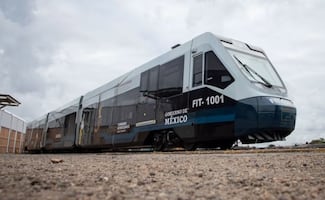Más Información

Caso Cecilia Monzón: Sentencian a 60 años de prisión a Javier López, por feminicidio de la activista; fue secretario de Gobierno en Puebla

Secretaría Anticorrupción detecta posible hackeo a bases de datos de instituciones públicas; abre investigaciones

FGR mantiene peritajes por descarrilamiento del Tren Interoceánico; recaba evidencia fotográfica y extrae caja negra

Tras descarrilamiento del Tren Interoceánico, autobuses dan servicio a turistas que ya tenían boleto

Rifas ilegales, posible causa del ataque a empresario del Mercado de Abastos en Zapopan: Secretario de Gobierno de Jalisco

Al menos 20 personas resultan lesionadas tras volcadura de vehículo de transporte público en Circuito Exterior Mexiquense
The global pandemic caused by COVID-19 is also tackled by air. With a crew comprised of a pilot, co-pilot, navy doctor, and flight nurse, five air ambulances of Mexico’s Navy Ministry (SEMAR) transfer patients who contracted the new disease from different states to Mexico City.
Four Learjet (45 and 31) airplanes and a King Air, equipped with transportation pods, ventilators, and medical supplies, have performed 14 flights from different parts of the country, including Guerrero, Veracruz, Sonora, Campeche, and Oaxaca.
At the SEMAR’s Air Station in Mexico City’s International Airport, pilot Luis Alberto Andrade Cruz, navy doctor Sumi Pasos Nagamatsu, and flight nurse Ariana Herrera Galicia keep an eye on an ambulance flight alert.

Navy doctor Sumi Pasos Nagamatsu explains that her duty is to monitor the patient does not have a new health complication.
Recommended:
They comprise the five crews in charge of the mission for which they were trained in the handling of patients infected with COVID-19 and received personal protection equipment as part of the implementation of the Navy’s Aid Plan in the stage of rendering assistance to the civil population during the virus health emergency.
Pilot Luis Alberto Andrade Cruz is in charge of one of the Learjet 45 planes, an aircraft the Navy uses as an air ambulance and that was reconverted to treat the new coronavirus.
“To date, we have performed 14 COVID-19 transfers and my task is to have control of the aircraft and to coordinate with the health personnel to perform the transfers. One of the characteristics of these planes is their speed, which is good for using them as air ambulances,” he asserts.

Wearing the air pilot uniform, Andrade Cruz explains that they have transferred up to two patients to Mexico City in a single day in flights that take from one to two hours, which need a lot of coordination with the health personnel regarding the barometric pressure and temperature to keep patients well during the trip.
“It requires great coordination and planning regarding the kind of patient, their condition because they could be in a serious but stable condition, that means they are able to carry on with the flight, so we have to have certainty of their health conditions; that is evaluated by health personnel and if everything is ok, we perform the flight. The health conditions of each patient will make a difference in the flight. As pilots, we are aware of it and aim for the flight to be as good as possible,” he adds.
Navy doctor Sumi Pasos Nagamatsu has participated in three transfers and explains that her task is to monitor the infected patient does not present any complication during the flight.

“We prepare the equipment, the coordination with the institutions where we will receive the patients, depending on the seriousness, we interact with specialist doctors and monitor the patients so that they have no complications,” she says.
Pasos Nagamatsu mentions that the service has been rendered both to the civil population, the military, and rightsholders, which makes her feel satisfaction to be able to help the population as an institution and to work along with a wide team, she stresses.
Recommended:
So far, she underscores, they have had no complications while transferring a patient, who once they are got off the plane, are taken to an ambulance that, in turn, takes them to a hospital.

Nurse Ariana Herrera explains that they try for the patient’s transfers to be as stable as possible and if some are in critical conditions, they use mechanic ventilators; those who are in stable conditions are provided with high-flow oxygen.
She is in charge of receiving patients, transferring them to the hospital receiving them, and disinfecting the ambulance for the next flight and has already partaken in four COVID-19 flights.
With pride, she asserts that to date, “we have not had any complication; we always try to keep in touch, to always be a team to be able to achieve better results.”
mp
Noticias según tus intereses
[Publicidad]
[Publicidad]








